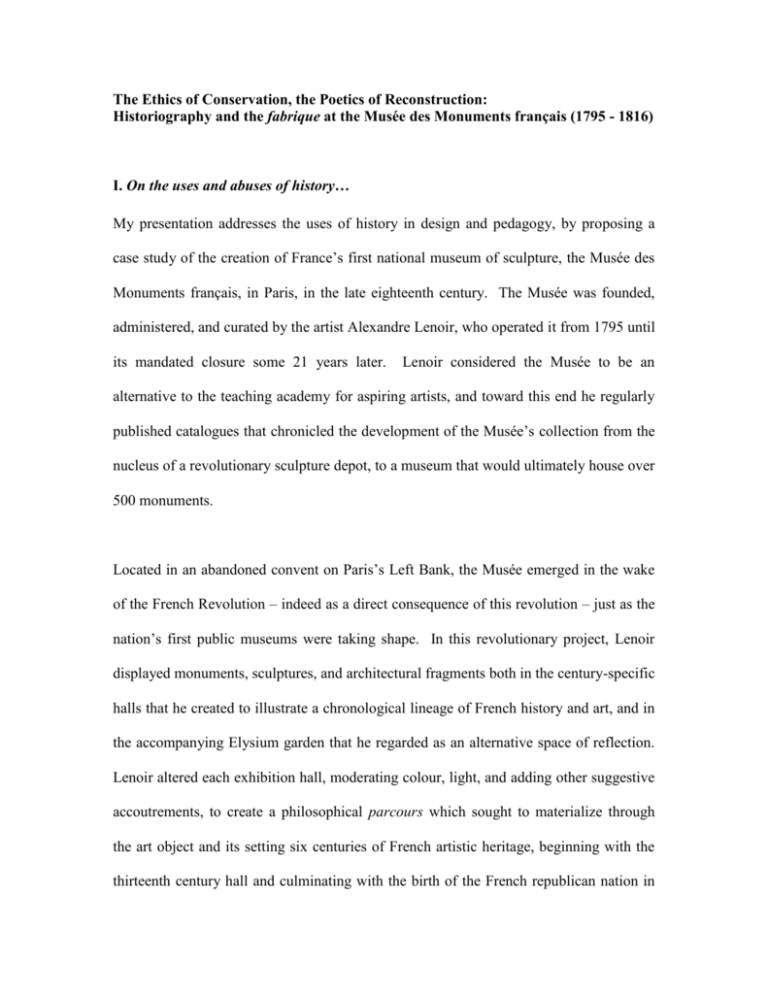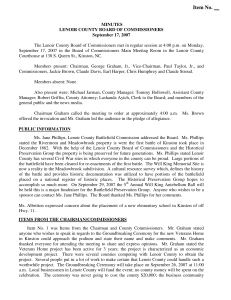The ethics of conservation, the poetics of reconstruction
advertisement

The Ethics of Conservation, the Poetics of Reconstruction: Historiography and the fabrique at the Musée des Monuments français (1795 - 1816) I. On the uses and abuses of history… My presentation addresses the uses of history in design and pedagogy, by proposing a case study of the creation of France’s first national museum of sculpture, the Musée des Monuments français, in Paris, in the late eighteenth century. The Musée was founded, administered, and curated by the artist Alexandre Lenoir, who operated it from 1795 until its mandated closure some 21 years later. Lenoir considered the Musée to be an alternative to the teaching academy for aspiring artists, and toward this end he regularly published catalogues that chronicled the development of the Musée’s collection from the nucleus of a revolutionary sculpture depot, to a museum that would ultimately house over 500 monuments. Located in an abandoned convent on Paris’s Left Bank, the Musée emerged in the wake of the French Revolution – indeed as a direct consequence of this revolution – just as the nation’s first public museums were taking shape. In this revolutionary project, Lenoir displayed monuments, sculptures, and architectural fragments both in the century-specific halls that he created to illustrate a chronological lineage of French history and art, and in the accompanying Elysium garden that he regarded as an alternative space of reflection. Lenoir altered each exhibition hall, moderating colour, light, and adding other suggestive accoutrements, to create a philosophical parcours which sought to materialize through the art object and its setting six centuries of French artistic heritage, beginning with the thirteenth century hall and culminating with the birth of the French republican nation in 2 the last decade of the eighteenth century. Lenoir’s curatorial interventions – simply put he innovated the period room and chronological display – popularized scenographic techniques that have today become incorporated into mainstream museological practice – not infrequently to problematic effect. Lenoir’s curatorial vision was informed by a desire to animate the past – literally to bring the past to life – an ambition that reflected the broader societal phenomena of both a changed sense of history, and the emergence of new attitudes to the uses of history in cultural and pedagogical practices. The development of the Musée des Monuments français is extremely prescient, for it emerged in the moment that history and art – hitherto two related and mutually enforcing human endeavours – would become irrevocably disengaged through the subsequent creation and institutionalization of academic disciplines. Lenoir’s project of the Musée, a self-proclaimed history of nation and art, developed at the dawn of this new age, and thus it had the distinction of defining what was essentially a nineteenth-century phenomenon (the public museum) with an eighteenth-century sensibility. In other words, Lenoir’s project was premised upon the strong belief that some form of access to truth derived not strictly from a factual or analytic presentation of material (as it would in later museographic forms), but rather from a heightened engagement with the object – even, or perhaps it is more accurate to say especially, if this object embodied truth through the coalescence of techne and poesis. If Lenoir’s scenographic interventions seemed innovative, many of them were in fact inspired by traditions existing outside of the museum paradigm, and born not of the French Revolution, but rather from established literary and urban contexts, most notably Carter, The Ethics of Conservation, the Poetics of Reconstruction CCA 14.IX.2007 3 the histoire monumentale and the picturesque garden. In these alternative spaces, where questions of representation were no less central than they were in the narrative history museum, new pictorial and literary discourses altered conventional historiographies and constructions of subjectivity. Of these two models – the literary and the spatial – I would like to discuss the latter, for it was through the creation and inclusion of the sculptural fabrications he called fabriques that Lenoir provided one of the greatest ethical challenges to modern museography. II. Designing the fabrique: un-ethical impulse, poetic endeavour The tradition of the fabrique had its origins in landscape painting in the mid-eighteenth century. The French artist and landscape theorist Claude-Henri Watelet coined the term fabrique in a 1756 entry in the Encyclopédie, though his description at that time was confined to the language of painting and its techniques. The term, if not the object itself, would re-appear in Watelet’s own treatise of 1774, Essai sur les jardins, and in his picturesque garden estate in the suburbs of Paris, Moulin Joli. Watelet concluded his treatise with correspondence to a friend, in which he described a contemplative walk in a pastoral French garden containing the popular features of a deserted island and fabrique to the medieval French heroine, Héloïse. Celebrating a Romantic appreciation of both the landscape and the solitary promenade, Watelet’s work anticipated Rousseau’s Reveries of the Solitary Walker, a series of ten essays or “walks” composed between late October 1776 and the philosopher’s death in July 1778. Carter, The Ethics of Conservation, the Poetics of Reconstruction CCA 14.IX.2007 4 The use of the fabrique by Lenoir at the Musée des Monuments français was of a slightly different order and intention than its precursor in Watelet’s garden. The distinction is primarily related to the object’s making – and this object’s status within the context of its display. Lenoir’s fabriques were sculptural constructions, often composed from the remains of others, that the curator created toward one of two ends: the first was pure invention, intended for the tombstones that Lenoir designed for burials in the Elysium garden-cemetery that was part of the larger program of the Musée; the second evolved out of Lenoir’s conservation and restoration practices, and from the need to repair the objects that arrived at the Musée either mutilated or heavily damaged. In many cases, Lenoir’s fabriques were, at their essence, assemblages of débris: discarded materials and architectural fragments that were in large supply following the Revolution. This débris had many useful functions for Lenoir, who often bartered these materials in exchange for labour provided by contemporary sculptors. The exchange benefited Lenoir, who was able to supplement his museum with objects at very little expense. Lenoir was well placed to recycle the materials of unwanted – and unclaimed – sculptures in his collection, however the practice appears to have been widespread. An example of this type of exchange occurred between Lenoir and a colleague by the name of Louis-Pierre Deseine. Lenoir and Deseine’s early correspondence indicates a certain complicity and shared attitude toward the recycling of objects of art. On 11 May, 1800, while completing the commission for busts he had received from Lenoir, Deseine wrote to Lenoir requesting more marble to replace a defective supply he had been given, and suggested that Lenoir look to modern tombs: “Vous avez encore plusieurs statues Carter, The Ethics of Conservation, the Poetics of Reconstruction CCA 14.IX.2007 5 modernes,” he wrote, “qui peuvent être sacrifiées sans crainte.”1 In light of this propensity to recycle, it is all the more surprising to find the concurrent use of relics in these designs. Again, correspondence with Deseine reveals something of Lenoir’s working process. While at work on a fabrique to house the burial of the medieval lovers Héloïse and Abélard – whose remains Lenoir had procured with great effort from their original resting place in Nogent-sur-Seine – Deseine requested the plaster death masks that had been made using the bones of Héloïse and Abélard, in order to render his design more expressive. It is worth quoting the passage at length, for the flamboyant language he used: “Songez à me procurer, le plus tôt possible, le plâtre des ossements de nos deux tendres victimes de l’amour le plus passionné. Quoique vieux, je compatis à leurs maux, et j’espère le prouver par l’expression que je m’efforcerai de donner à leur visage. L’une brûle toujours de l’ardent désir de subir la loi du vainqueur, l’autre dans le coeur duquel l’amour exerce toujours son empire, gémit d’être désarmé...Ah! mon ami, que je les plains!”2 Rest assured, the incident was not an isolated one, as Lenoir’s attachment to the relic is confirmed in numerous entries in the Archives du Musée des Monuments français, which record the curator’s tendency to distribute human remains to friends and acquaintances. In some instances, these appear to have been unsollicited “gifts,” such as was the case of the relics that Lenoir sent to the Princess of Isenburg following her visit in 1810,3 while in others, Lenoir was clearly approached by individuals who, like himself, were constructing monuments or shrines to famous French personalities. It is not Ministère de l’Instruction publique, Inventaire générale des richesses d’art de la France: Archives du Musée des monuments français, 3 vols. (Paris: E. Plon, Nourrit, 1883-1897) Vol. 2, Article 270, 358-359. Emphasis my own. 2 Archives, Vol. 2, Article 270, 359. 3 Archives, Vol 3, Article 454, 131. 1 Carter, The Ethics of Conservation, the Poetics of Reconstruction CCA 14.IX.2007 6 inconceivable that Lenoir’s obsession was born of the royal exhumations he attended at the Basilique St.-Denis and methodically sketched during the height of the Terreur, moments that were as intensely destructive as they were revelatory. Lenoir’s apparent necrophiliac tendencies notwithstanding, the cult of the relic was undeniably significant in the network of associations surrounding the curator’s design activities. By virtue of its presence in the creative act, the relic, however small a fragment of an authentic object, provided the tangible link to the past that Lenoir sought to reconstruct at the Musée. Be it the corporal remains of Molière buried beneath a contemporary fabrique, or the use of the relic to make a more “plausible” face for a reclining Héloïse, the relic promised, in some small way, an affective presence. Given the poetic intent that inspired the making of the fabrique, its place within the museographic setting of the Musée des Monuments français introduced a different set of issues than it previously had in the garden of Moulin Joli and other eighteenth-century landscapes. Most significantly, the foundational question of authenticity within the museum institution, which, by the twentieth century, would become a pivotal issue, was first raised and debated. By their assemblage of diverse sculptural elements, Lenoir’s fabriques and installations introduced an ethical dilemma to the didactic aims of the nascent public museum, firmly opposing the desire for an authentic experience against the need for an evocative one. It was in the designs that Lenoir undertook himself as pure fictional creations that he seems to have taken the greatest liberty – and which demonstrated the most outlandish Carter, The Ethics of Conservation, the Poetics of Reconstruction CCA 14.IX.2007 7 and unorthodox results. The fabriques in the Elysium were often odd sculptural constructions in their complex and creative combination of emblematic and symbolic iconographies, and it is doubtful that any single reading was intended for these objects. Lenoir described the monument dedicated to the antiquarian and historian Bernard de Montfauçon, for example, as a composite of “hieroglyphs, Egyptian figures, Greek reliefs, figures from the late Roman Empire and remains of monuments from the first years of the French monarchy”4 – a hybrid arrangement of motifs intended to recall the diverse historical interests, and writings, of the scholar. This was one of many monuments that Lenoir created from the remains of others: a curious conservationist practice by our current standards, and not without significant criticism in his own time as well. Although Lenoir insisted that the monuments he fabricated combined only materials from similar historical eras, he did not always abide by this dictum. In the very popular chapel he re-created for Héloïse and Abélard, Lenoir combined a newly commissioned neo-gothic canopy, the twelfth-century funerary monuments he had purchased from their original setting at the Abbey of Paraclet, and the contemporary death mask of Héloïse that he had commissioned from Deseine. As Lenoir confessed in his own writing, in the absence of authentic objects, an invention will do, providing that it conformed to the architectural “character” of the period. This very viewpoint also underlay Lenoir’s spatial conceptions of the period halls. It is difficult to say that neither of these two traditions of the fabrique conformed to contemporary conservation policies, if only because France’s political views on culture 4 Alexandre Lenoir, Musée Impérial des Monumens français. Histoire des arts en France, et description chronologique des statues en marbre et en bronze, bas-reliefs et tombeaux des hommes et des femmes célèbres, qui sont réunis dans ce Musée (Paris: Hacquart, 1810), 290. My own translation. Carter, The Ethics of Conservation, the Poetics of Reconstruction CCA 14.IX.2007 8 were only beginning to be formulated and theorized, notably in a document entitled les Quatre Instructions Initiales (1790-1791), and the later report produced by the comparative anatomist Félix Vicq d’Azyr and Dom Germain Poirier, also entitled Instruction (1794). These documents were effectively guidelines to an ethics and praxis for historic monuments, yet significantly what was absent from either document was the specific articulation of a policy on restoration, to accompany those on conservation and preservation. Les quatre instructions initiales was published by the Commission of Monuments and saw the act of conservation as little more than preserving the status quo: statues were to be kept in their current location and under guard so as to prevent dispersion or deterioration. The overriding concern at this stage in post-revolution cultural reform was to determine what objects of France’s newly nationalized collection were worth keeping and to inventory these. Three years later (15 March 1794), Vicq d’Azyr and Dom Poirier produced a much more extensive document on conservation, in which they popularized the idea of putting objects to the service of public instruction and the State’s regeneration. Though more comprehensive in scope, this document also interpreted conservation as an opportunity for inventory – one might consider this mania for recording a form of pre-emptive conservation – however remarkably little was articulated on the actual subject of restoration or reconstruction of sculpture or architecture. No guidelines or policies for restoring such objects damaged by the Revolution actually existed.5 In the case of Lenoir, whose intention it was to conserve historic monuments by reconfiguring the heaps of sculpture that lay on the depot’s floor, Félix Vicq d’Azyr and Dom Germain Poirier, “Instruction sur la manière d’inventorier et de conserver, dans toute l’étendue de la République, tous les objets qui peuvent servir aux arts, aux sciences et à l’enseignement, proposée par la commission temporaire des arts, et adaptée par le comité d’instruction publique de la Convention nationale, 25 ventôse an II (15 March 1794),” in La Culture des Sans-Culottes: Le Premier Dossier du Patrimoine 1789-1798, eds. Deloche and Leniaud (Paris-Montpellier: Éditions de Paris/Presses de Languedoc, 1989), 230. 5 Carter, The Ethics of Conservation, the Poetics of Reconstruction CCA 14.IX.2007 9 the fabrique tipped the scale toward artistic innovation over that of conservation, even if, as he famously proclaimed, to leave disassembled monuments in a heap would surely contribute to their ruin. Lenoir’s intent in using the fabrique was to arouse feelings and emotions, much like the traditions popularized by the eighteenth-century irregular garden and its use of the fabrique-ruin. Just as the picturesque garden movement with its follies and fabriques had emerged as the alter ego of the overseeing château in eighteenth-century traditions, so too did Lenoir’s Elysium perform a discursive transgression to the official discourse of the interior chronological narrative and historiography of the Musée. The fabrique, then, permitted Lenoir to pursue his ideal of a museum of progress by illustrating a perfectable history. Contemporaneous to Constantin-François Volney’s meditative and highly influential Ruines, ou, Méditation sur les révolutions des empires (1791), which used the ruin as a departure point for moral reflections on the decay or decline of empires, there could be no greater antithesis in the creative endeavours produced during France’s era of revolution than Lenoir’s own project of the Musée, which nevertheless shared a similar pedagogical intention to sum history up through the subjects of empire and revolution. Where Volney sought enlightenment in human actions through his invocation of the ruin, Lenoir’s was an effort to correct human and artistic shortcomings through his very re-construction of the ruin. Carter, The Ethics of Conservation, the Poetics of Reconstruction CCA 14.IX.2007 10 Thus unlike his contemporary John Soane, in whose museum of architecture in London the fragment was valued precisely for its poetic associations, Lenoir could not and did not leave the object in a fragmented state. His obsession with reconfiguring the object to a pristine, though not necessarily “authentic” condition, seems to have been informed more by a literary sensibility, such as that espoused by Rousseau, than by the prevailing views of his contemporaries and immediate predecessors in architecture and the fine arts. Just like the rhetorical device of the “embellishment” – Rousseau’s equivalent to Lenoir’s fabriques – sought to overcome memory lapses, not to confabulate or to promote falsity, so too did Lenoir’s impetus seem to have been a post-Revolution need to fill in the void: to re-write a cohesive history of France and to render this history visible, tangible, felt, even as the nation itself was revising its own history. Perhaps Antonio Gramsci best characterized the significance of Lenoir’s work within its post-Ancien régime context in an unrelated passage he wrote in the Prison Notebooks: “The crisis consists precisely in the fact that the old is dying and the new cannot be born; in this interregnum a great variety of morbid symptoms appears.”6 Conclusion Not all projects undertaken in the post-Ancien régime were of such morbid character as the lengths to which Lenoir took the ruin and the fabrique, however many were concerted efforts to construct a new modern self, and to this end, public spaces and objects figured prominently. This construction of the self involved adopting a specific attitude to the past and to objects. Monuments in particular were poignant statements about history, but ones that could be modified. 6 Antonio Gramsci, The Prison Notebooks, quoted in Geoffrey James, Morbid Symptons: Arcadia and the French Revolution. (Princeton, N.J.: Princeton Architectural Press, 1986) [3]. Carter, The Ethics of Conservation, the Poetics of Reconstruction CCA 14.IX.2007 11 Like his contemporary Rousseau, who freely resorted to invention to fill in the gaps, Lenoir used the compositional freedom of the fabrique to achieve veracity rather than accuracy in the individual monument. With their emphasis on verisimilitude as distinct from exactness, these objects functioned outside of an official “national” narrative as poetic suggestions of human accomplishment, and made appeal to the body – not simply the intellect – through the heightened sensorial devices and associations of the mythic elysian garden. These monuments’ presence in the garden highlighted universal themes that served to challenge modern historiography and a past burdened by a relentless obsession to record all things historical. In this manner, the Musée des Monuments français can be said to have upheld the aesthetic, historical, and didactic innovations that conditioned the foundations of the modern museum, at the same time that it sewed the seeds for this institution’s self-reflexive, philosophical critique. Lenoir’s appropriation of the narrative techniques of contemporary landscape theory positioned the Elysium as an act of poetry in the manner it put history to the service of life rather than bearing the burden of the past – recalling Nietzsche’s caution of the hypertrophic sensibility that conditioned the historical sciences at the turn of the nineteenth century.7 Only poetry, observed Aristotle, had the capacity to represent the past in universal terms; history dealt with the particulars. In conclusion, Lenoir’s curatorial practice at the Musée des Monuments français reveals a very different motivation for animating the past than the one we are faced with today. Far from a desire to render the visitor a “victim” of the traumatic historical narratives that Frederick Nietzsche, “On the Utility and Liability of History for Life,” Unfashionable Observations (Stanford, CA: Stanford University Press, 1995), 83-167. 7 Carter, The Ethics of Conservation, the Poetics of Reconstruction CCA 14.IX.2007 12 are the focus of many contemporary national history museums, Lenoir’s museographic innovations were entirely different. Beyond realizing the larger pedagogical and historiographical objectives of the French Revolution, Lenoir’s ambitions for the Musée were to restitute the fractured ethos of a nation recovering from a severed past. Carter, The Ethics of Conservation, the Poetics of Reconstruction CCA 14.IX.2007





